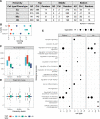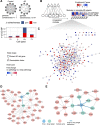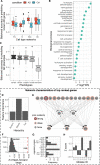Single-cell network biology characterizes cell type gene regulation for drug repurposing and phenotype prediction in Alzheimer's disease
- PMID: 35849618
- PMCID: PMC9333448
- DOI: 10.1371/journal.pcbi.1010287
Single-cell network biology characterizes cell type gene regulation for drug repurposing and phenotype prediction in Alzheimer's disease
Abstract
Dysregulation of gene expression in Alzheimer's disease (AD) remains elusive, especially at the cell type level. Gene regulatory network, a key molecular mechanism linking transcription factors (TFs) and regulatory elements to govern gene expression, can change across cell types in the human brain and thus serve as a model for studying gene dysregulation in AD. However, AD-induced regulatory changes across brain cell types remains uncharted. To address this, we integrated single-cell multi-omics datasets to predict the gene regulatory networks of four major cell types, excitatory and inhibitory neurons, microglia and oligodendrocytes, in control and AD brains. Importantly, we analyzed and compared the structural and topological features of networks across cell types and examined changes in AD. Our analysis shows that hub TFs are largely common across cell types and AD-related changes are relatively more prominent in some cell types (e.g., microglia). The regulatory logics of enriched network motifs (e.g., feed-forward loops) further uncover cell type-specific TF-TF cooperativities in gene regulation. The cell type networks are also highly modular and several network modules with cell-type-specific expression changes in AD pathology are enriched with AD-risk genes. The further disease-module-drug association analysis suggests cell-type candidate drugs and their potential target genes. Finally, our network-based machine learning analysis systematically prioritized cell type risk genes likely involved in AD. Our strategy is validated using an independent dataset which showed that top ranked genes can predict clinical phenotypes (e.g., cognitive impairment) of AD with reasonable accuracy. Overall, this single-cell network biology analysis provides a comprehensive map linking genes, regulatory networks, cell types and drug targets and reveals cell-type gene dysregulation in AD.
Conflict of interest statement
The authors have declared that no competing interests exist.
Figures






Similar articles
-
Integrative network analysis of nineteen brain regions identifies molecular signatures and networks underlying selective regional vulnerability to Alzheimer's disease.Genome Med. 2016 Nov 1;8(1):104. doi: 10.1186/s13073-016-0355-3. Genome Med. 2016. PMID: 27799057 Free PMC article.
-
Predicting gene regulatory networks from multi-omics to link genetic risk variants and neuroimmunology to Alzheimer's disease phenotypes.bioRxiv [Preprint]. 2021 Sep 20:2021.06.21.449165. doi: 10.1101/2021.06.21.449165. bioRxiv. 2021. PMID: 34189529 Free PMC article. Preprint.
-
Predicting brain-regional gene regulatory networks from multi-omics for Alzheimer's disease phenotypes and Covid-19 severity.Hum Mol Genet. 2023 May 18;32(11):1797-1813. doi: 10.1093/hmg/ddad009. Hum Mol Genet. 2023. PMID: 36648426 Free PMC article.
-
Harnessing endophenotypes and network medicine for Alzheimer's drug repurposing.Med Res Rev. 2020 Nov;40(6):2386-2426. doi: 10.1002/med.21709. Epub 2020 Jul 13. Med Res Rev. 2020. PMID: 32656864 Free PMC article. Review.
-
Gene networks and systems biology in Alzheimer's disease: Insights from multi-omics approaches.Alzheimers Dement. 2024 May;20(5):3587-3605. doi: 10.1002/alz.13790. Epub 2024 Mar 27. Alzheimers Dement. 2024. PMID: 38534018 Free PMC article. Review.
Cited by
-
Single nucleus multiomics identifies ZEB1 and MAFB as candidate regulators of Alzheimer's disease-specific cis-regulatory elements.Cell Genom. 2023 Feb 2;3(3):100263. doi: 10.1016/j.xgen.2023.100263. eCollection 2023 Mar 8. Cell Genom. 2023. PMID: 36950385 Free PMC article.
-
Evaluation of altered cell-cell communication between glia and neurons in the hippocampus of 3xTg-AD mice at two time points.bioRxiv [Preprint]. 2024 Sep 19:2024.05.21.595199. doi: 10.1101/2024.05.21.595199. bioRxiv. 2024. Update in: J Cell Commun Signal. 2025 Feb 28;19(1):e70006. doi: 10.1002/ccs3.70006. PMID: 38826305 Free PMC article. Updated. Preprint.
-
Approaches for Benchmarking Single-Cell Gene Regulatory Network Methods.Bioinform Biol Insights. 2024 Nov 4;18:11779322241287120. doi: 10.1177/11779322241287120. eCollection 2024. Bioinform Biol Insights. 2024. PMID: 39502448 Free PMC article. Review.
-
Signals in the Cells: Multimodal and Contextualized Machine Learning Foundations for Therapeutics.bioRxiv [Preprint]. 2024 Nov 12:2024.06.12.598655. doi: 10.1101/2024.06.12.598655. bioRxiv. 2024. PMID: 38948789 Free PMC article. Preprint.
-
Evaluation of altered cell-cell communication between glia and neurons in the hippocampus of 3xTg-AD mice at two time points.J Cell Commun Signal. 2025 Feb 28;19(1):e70006. doi: 10.1002/ccs3.70006. eCollection 2025 Mar. J Cell Commun Signal. 2025. PMID: 40026671 Free PMC article.
References
Publication types
MeSH terms
Grants and funding
LinkOut - more resources
Full Text Sources
Medical
Miscellaneous

